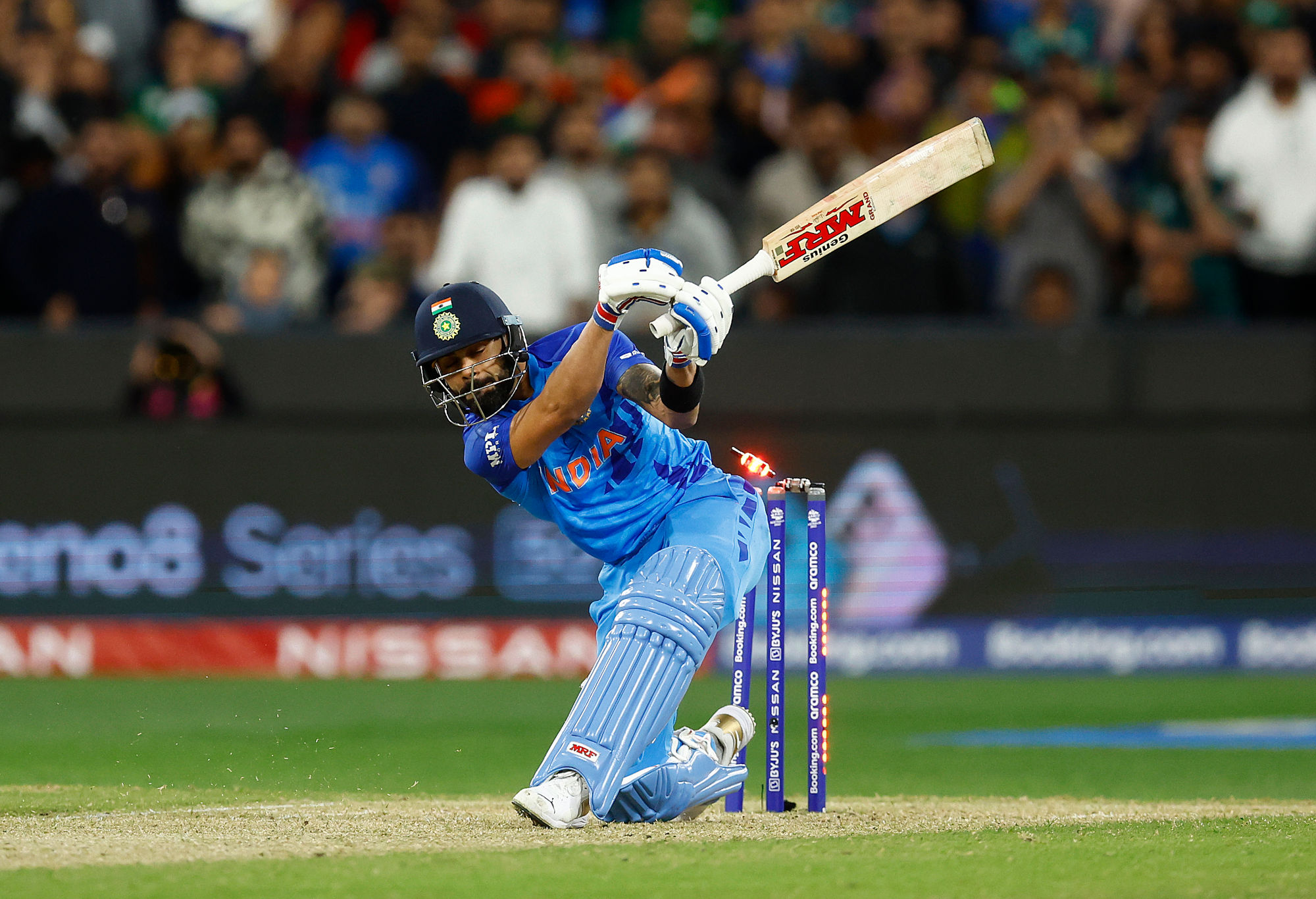Batters get the benefit of the doubt in cricket but the ICC’s latest change in playing conditions now means they can score runs even if they miss the ball and get bowled.
It can only happen from a free hit in the limited overs formats but the change to the rules makes little sense.
If a batter on strike after a no-ball gets bowled and runs are scored off the ricochet, they will now go onto their tally, rather than count as byes in the scorebook.
The ICC’s cricket committee, chaired by former India skipper Sourav Ganguly, announced during the week that “any runs scored off a free hit when the ball hits the stumps will count as team runs scored, to be consistent with all other runs scored from a free hit”.

Virat Kohli is bowled by Mohammad Nawaz off a free hit. (Photo by Daniel Pockett-ICC/ICC via Getty Images)
If the ball misses the bat (and gloves) and runs are scored off the body, leg byes will be signalled as normal and likewise if the wicketkeeper fumbles after the batter makes no contact, then byes will be awarded.
But if the bowler manages to get through the striker’s defences and hits the stumps, any runs scored will go onto the batter’s total even if they have failed to land willow on leather.
That’s a bizarre scenario.
The ICC has opened a can of worms that should have been left well alone with this change.
You could end up with a situation where a player is a few runs short of a half-century or a hundred and they have to celebrate their achievement after not even hitting the ball for their milestone moment.
The question of what should happen in the rare instance of players being bowled from a free hit flared up after an incident in the final over of the memorable India vs Pakistan T20 World Cup clash at the MCG last year.
With India needing five runs from three deliveries, Virat Kohli was bowled off a free hit delivery from Mohammad Rizwan and scampered through for three byes.
There were calls afterwards for the rules to be changed to a dead ball if a batter is bowled from a free hit as they have already paid the price for their previous no-ball by not being able to take a wicket with the ensuing delivery.
Former Australia skipper Mark Taylor got on the front foot to say “I think if the batter is bowled or caught off the free hit, you’re not out but the ball should then be dead, that would be fair and reasonable.
“You’ve got the advantage of not being out off a free hit, but you shouldn’t benefit a second time from what would normally be considered a dismissal.”
But that is not the way to go either. Anything that discourages bowlers from overstepping the mark needs to remain but this latest alteration to the playing condition is yet another example of batters getting too much preferential treatment.
Teams should still get the runs from a deflection off the wicket on a free hit but to credit them to the batter who has been bowled is absurd.
It’s unlikely anyone will ever try to copy Brad Haddin’s idea for how to play a free hit.
In the early days of the modern rule in 2005, the Australian keeper stepped aside while batting in a T20 international to allow Pakistani speedster Shoaib Akhtar to bowl him out so he could then scurry through for a bye.
Perhaps he thought they could still steal a single with the keeper so far back to a bowler of Akhtar’s pace but surely it’s a better idea to stay in a normal batting stance and try to hit the ball to or over the boundary.
Haddin’s strange ploy was actually from the second successive free hit he’d faced – the first time he’d also dropped behind the wicket and actually swung the ball to deep midwicket after it missed the stumps.
“I thought if I got behind the stumps and the ball hit the stumps, it could deflect for four,” he explained at the time. “Also it would give me more time to free my arms up and hit the ball. It was something different. Maybe I over-theorised a little bit, but we were all out there to have some fun.”
The ICC committee made a couple of other changes during the week which make much more sense.
Helmets are now compulsory for all batters when facing fast bowlers as well as wicketkeepers up to the stumps and close-in fielders while they have scrapped the requirement for the umpires to issue a “soft signal” when referring a catch to the third umpire.
Particularly for outfield catches a long way from where the two on-field officials are standing, they were often guessing or relying on the player’s opinion when making those soft signals. And a fielder can often unknowingly think they’ve caught a ball fairly without realising it has grazed the turf.
They will never please everyone when it comes to ruling on low catches which can often come down to a matter of judgement when there is no definitive vision.
But the removal of the soft signal means the third umpire can make their call based purely on what they see on their high-definition replays in slow motion rather than having to find sufficient evidence to overturn what is frequently little more than an educated guess from their on-field comrades.
And of course, when it’s unclear, they will continue to give the batter the benefit of the doubt.
>Cricket News

%20(3).jpeg)




0 Comments